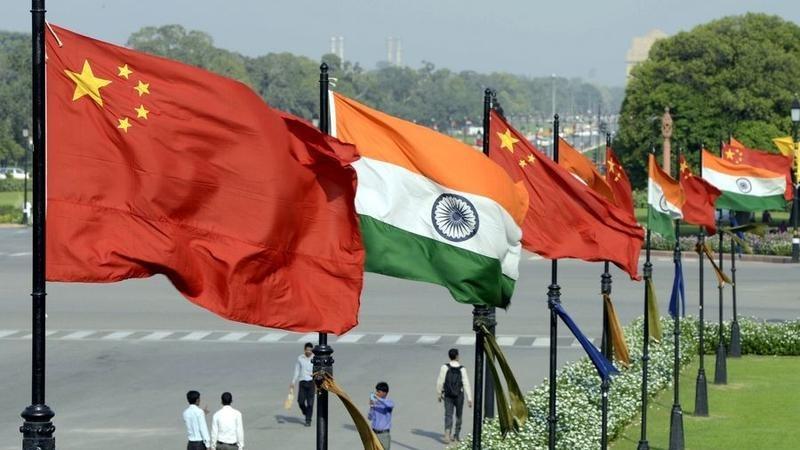 Indian and Chinese national flags flutter side by side at the Raisina hills in New Delhi, India, in this file photo. (PHOTO / XINHUA)
Indian and Chinese national flags flutter side by side at the Raisina hills in New Delhi, India, in this file photo. (PHOTO / XINHUA)
NEW DELHI – Diplomats of China and India discussed issues about troops along the western sector of the Line of Actual Control and exchanged other measures to bring normalcy in border areas at the 26th meeting of the Working Mechanism for Consultation and Coordination on Border Affairs.
The meeting on Feb 22 was co-chaired by Director General of the Department of Boundary and Oceanic Affairs of the Foreign Ministry of China, Hong Liang, and Joint Secretary of the East Asia Division and External Affairs Minister's Office of the Ministry of External Affairs of India, Shilpak Ambule.
In Beijing, the Ministry of Foreign Affairs of China issued a separate statement, stating the two sides reviewed “positive” progress in border management, affirmed the results of disengagement of border troops of the two countries at Galwan Valley and four other locations, and “exchanged views frankly” during the meeting, according to the statement issued by the ministry.
“The two sides agreed to move forward on the basis of the consensus previously reached, accelerate the resolution of issues related to the western section of the Sino-Indian border, and reach a mutually acceptable solution at an early date; the two sides explored other measures to further ease the border situation and agreed to work to promote the border situation into a normalized control phase,” the statement said.
Also terming the meeting a good move, Indian analysts said it was a positive sign, and both sides want to bring normalcy to the border areas at the earliest.
Both sides during the meeting acknowledged the successful withdrawal of Chinese and Indian forces from border regions during the conference and they also exchanged opinions regarding the next phase of boundary dispute negotiations.
“The two sides reviewed the situation along the Line of Actual Control (LAC) in the Western Sector of India-China border areas and discussed proposals for disengagement in the remaining areas in an open and constructive manner, which would help in restoration of peace and tranquility along the LAC in Western Sector and create conditions for restoration of normalcy in bilateral relations,” according to press statement issued by the India’s Federal Ministry Of External Affairs.
This was the first WMCC meeting since the 14th meeting held in July 2019, the statement said. Amidst the effort to restore peace and normalcy by both sides, the in-person meeting gained significance.
Besides the border issues, the officials discussed other measures to de-escalate tensions and normalize control in the region. They also agreed to maintain frequent communication through diplomatic and military channels and both sides agreed to hold the 18th round of military talks at an early date.
The two sides reviewed the positive progress made in the early stage of China-India border control, affirmed the results of the disengagement. They had a candid and in-depth exchange of views on the approach for the next stage of consultation, it added.
The two sides agreed to “actively implement the important consensus between the leaders of the two countries to promote further stabilization of the border situation,” it said.
Ambule also met Assistant Foreign Minister Hua Chunying and they discussed bilateral ties and the situation at the border, it said.
Prof Atul Bhardwaj, adjunct fellow at the Institute of Chinese Studies in New Delhi, said this is a good move. Indian policy is based on realism and pragmatism. At this stage, both sides want peace on their borders so they can focus on becoming economically stronger.
“Peace with our neighbors helps millions of Indians to live in hope of a brighter future,” Bhardwaj added.
Both sides have agreed to meet again and obviously the talks are keeping the temperature down, said Sukh Deo Muni, former Indian Envoy to the Southeast Asian countries on United Nations Security Council Reforms and professor emeritus at the School of International Studies, Jawaharlal Nehru University, New Delhi.
The problem has to be resolved realistically, bilateral talks is the only way to resolve the remaining border issues, it can’t be resolve unilaterally or by force by any side, former Indian Army chief Shankar Roy Chowdhury said, adding it must be settled amicably and bilaterally.
It will take time to resolve remaining border issues. It will be a long exercise, don’t expect results overnight, former Brigadier of Indian Army P K Sanyal said.
The WMCC was established in 2012 as an institutional mechanism for consultation and coordination for the maintenance of peace and tranquility in the border areas. But, since Covid-19 epidemic, all of its sessions to resolve border disputes were held virtually.
The 17th round of military talks was held at the Chushul-Moldo border meeting point on the Chinese side in December last year. A joint statement released after the talks had said that both sides exchanged views in an "open and constructive" manner to resolve the "relevant issues" and described the talks as "frank and in-depth".
In an interview broadcast on Feb 21, Indian foreign minister Subrahmanyam Jaishankar said, "India's relationship with major powers is good. China is an exception because it violated agreements that we've had and has a posture at the border and as a result we have a counter posture.”
The writer is a freelance journalist for China Daily.


